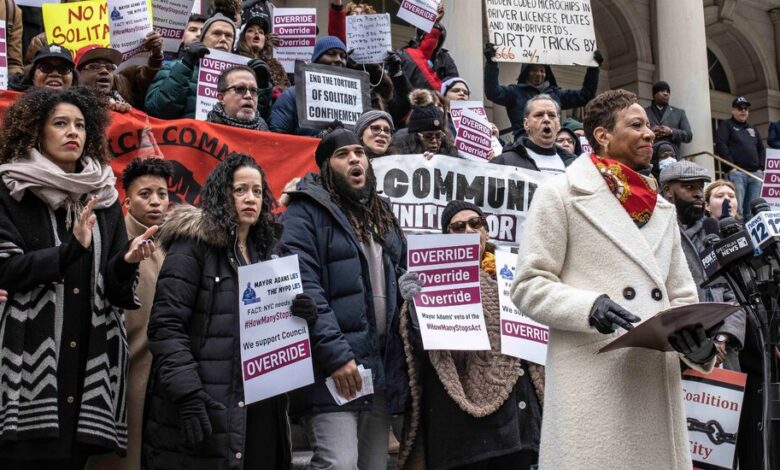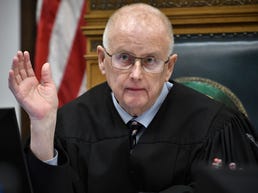NYPD Stops Act: What to Know About the Law Requiring More Data

The New York City Council last week required police officers to record the race, age and gender of most people they approach, overriding Mayor Eric Adams’s veto and establishing a law that its supporters say will give a fuller picture of whom officers are stopping during investigations.
The law, known as the How Many Stops Act, is meant to improve the Police Department’s data-collection efforts and to prevent unlawful encounters with young people of color and other abuses.
Mr. Adams objects to an element of the legislation that requires officers to record their observations of residents they approach for any law enforcement purpose, including asking a person to help find a fleeing suspect or a missing person.
The mayor has said that the police will follow the law, which takes effect in July. Here is a closer look at what it is supposed to accomplish and how it may affect the police and the public:
What does the law do?
The law requires officers to collect and share a wide spectrum of information about low-level interactions with members of the public.
According to the Police Department’s patrol guide, there are three levels of interaction that occur during “investigative encounters.”
Level 1 is when an officer requests information from a person who is not a suspect. The person is under no obligation to respond to such requests.
“The person may refuse to answer questions,” the patrol guide says, “or walk or even run away.”
Level 2 is when an officer begins to suspect that a person has committed a crime. As with a Level 1 interaction, the officer can ask what someone saw, their name and address and where they are coming from. Officers can ask someone they consider a suspect to consent to a search. As with a Level 1 interaction, the person can walk away and refuse to answer questions.
Level 3 stops occur when the police have a stronger suspicion that a person has committed a crime. In such instances, the patrol guide says, an officer may use “reasonable force” to stop a person, ask “accusatory” questions and frisk the person “if the officer has reasonable suspicion that the person is armed and dangerous.”
The police are already under a federal requirement to collect and share detailed information about Level 3 stops. The new law requires that they provide similar information for Level 1 and Level 2 stops, including the reason for any inquiry, demographic details about the person being stopped and why the stop was made.
The information would be stored permanently and accessible to the public on the department’s website.
The law does not require that officers keep detailed records about casual conversations like greeting people on the street or giving directions.
Why do supporters say it’s necessary?
In 2013, a federal judge ruled that the Police Department’s practice of stopping and frisking people was unconstitutional and targeted people of color, particularly young Black and Latino men and teenagers.
A monitor was appointed to ensure that the practice ended, but in June, the monitor reported that the department’s anti-crime units were still stopping too many people unlawfully.
Supporters of the law also cited the department’s history of underreporting and misclassification of stops.
Jumaane Williams, the city’s public advocate and a sponsor of the legislation, said it would help “curb the abuses of stop, question, and frisk.”
Many young people have complained about being approached by the police while walking through public housing developments or leaving the subway, making them feeling as though the police consider them criminals, proponents of the law said. They are also unlikely to know they are not obligated to stop under Level 1 or even Level 2 guidelines.
“When accurate data is available, we as policymakers are equipped with the information necessary to craft and implement policy solutions,” Councilman Yusef Salaam, the chair of the public safety committee, said on Tuesday.
Mr. Salaam, a newly elected council member who was wrongly convicted in 1990 as a member of the Central Park Five, was stopped by a police officer last month while driving with his family. The officer let him go, but Mr. Salaam said he did not give a reason for the stop. The encounter, he said, demonstrated why the new law was needed.
The law’s supporters say the police can record the newly required data using the same smartphone app they already use to log other encounters, and that doing so would not take more than 30 seconds. They said officers do not need to record the information right away; they can do it at the end of a shift or an investigation.
Why do the police and the mayor object?
The police say their main argument with the new law is the requirement that Level 1 interactions be recorded in detail. The problem, the police say, is that there are so many stops in this category and that they occur under circumstances that are fluid and fast moving.
In 2022, officers recorded more than 3.2 million videos classified as Level 1 encounters, Michael Clarke, the department’s director of legislative affairs, told the City Council during a hearing last March.
Edward Caban, the police commissioner, cited the example of a missing person when reporters asked him about the legislation on Wednesday. Mr. Caban asked whether an officer should be expected to jot down demographic data as critical seconds tick by.
“What are you going to do?” he said. “You’re going to ask every single person you come in contact with?”
During the debate over the bill, the Police Department released a three-minute video that it described as a “simulation” of conditions under the new law. The video showed a young female officer trying to help a mother find a missing child. The officer looks beleaguered and stressed out as she records the details of each of her encounters with witnesses and, later, when she is at her desk trying to finish her paperwork as a 911 call comes in.
Reporting the information after an investigation or shift could result in excessive overtime payments, Commissioner Caban said.
Under the law, officers are not required to ask for a person’s age, race or gender; they will generally need to record their answers based on observation. That data-gathering approach is inherently flawed, John Chell, the chief of patrol who oversees the rank and file, said during an interview with reporters on Wednesday.
“If we’re talking about transparency, I don’t get what that means when I have to guess your race, sex and age,” he said.
What comes next?
The Police Department has about five months to devise rules and technology to put the law into practice.
Commissioner Caban said he understood public concerns about officers’ low-level interactions with young people of color and said he was willing to “come to the table” with the City Council to reach a consensus on that issue.
Adrienne Adams, speaker of the council, said there would be no changes to the law, but she and Mr. Williams said they welcomed the opportunity to discuss how it would be executed.
Mr. Salaam said the department would have “significant flexibility” in the law’s implementation.
“The N.Y.P.D. has already found ways to conduct reporting without interfering in other tasks, and there is no reason the reporting required by this law cannot be done the same way,” he said.




